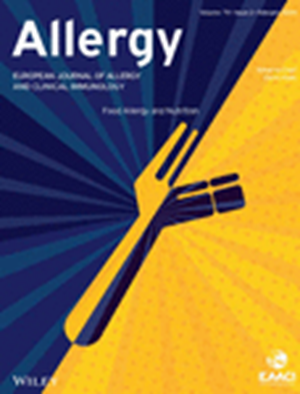皮肤介导的致敏作用中的嗜碱性粒细胞驱动气道挑战小鼠随后的肺部炎症。
IF 12
1区 医学
Q1 ALLERGY
引用次数: 0
摘要
背景:过敏性皮炎(AD)和哮喘被认为是流行病学上相关的过敏性合并症,两者都以全身IgE水平升高和2型免疫为特征。嗜碱性细胞通过产生白细胞介素-4 (IL-4)在这些反应中发挥关键作用,白细胞介素-4是IgE合成和过敏性炎症所必需的。然而,它们对AD发展为哮喘的具体影响尚不清楚。方法采用嗜碱性粒细胞缺乏Mcpt8Cre小鼠和暂时性嗜碱性粒细胞缺失小鼠的AD模型,局部应用维生素D类似物MC903诱导TSLP报警,导致AD样症状。此外,我们局部应用卵清蛋白(OVA)作为模型过敏原来追踪过敏原特异性免疫反应。我们通过分析生发中心反应来确定过敏原特异性抗体的形成,并测量血清抗体浓度和脾和肺中嗜碱性粒细胞的IgE负荷。我们进一步对皮肤致敏的小鼠进行过敏反应和过敏性肺炎症模型的挑战。结果:我们的研究结果表明,嗜碱性粒细胞促进皮肤屏障完整性的丧失、过敏原特异性IgE的形成和随后的过敏反应。致敏过程中选择性地减少嗜碱性粒细胞可显著减少ige依赖性过敏反应和肺部炎症。在受损肺中,炎症和嗜酸性粒细胞的减少伴随着趋化因子CCL17和CCL24水平的降低,CCL17和CCL24分别吸引Th2细胞和嗜酸性粒细胞。值得注意的是,在致敏过程中,il - 4和il - 13不受嗜碱性粒细胞减少的影响,但在永久缺乏嗜碱性粒细胞的小鼠中却减少了。结论嗜碱性粒细胞促进IgE的形成和肺部对皮肤接触过敏原的致敏,并驱动继发性过敏原诱导的肺部炎症。我们将嗜碱性细胞在致敏中的作用与其在过敏反应或肺部炎症期间的效应功能分开,设想新的策略来预防过敏性合并症的发展。本文章由计算机程序翻译,如有差异,请以英文原文为准。
Basophils in Skin-Mediated Sensitization Drive Subsequent Lung Inflammation in Airway-Challenged Mice.
BACKGROUND
Atopic dermatitis (AD) and asthma are observed as epidemiologically linked allergic comorbidities, both characterized by elevated systemic IgE levels and type 2 immunity. Basophils play a pivotal role in these responses by producing interleukin-4 (IL-4), which is essential for IgE synthesis and allergic inflammation. However, their specific impact on the progression from AD to asthma remains unclear.
METHODS
We utilized an AD model in basophil-deficient Mcpt8Cre mice and temporarily basophil-depleted mice, where topical application of the vitamin D analog MC903 induced the alarmin TSLP, resulting in AD-like symptoms. In addition, we topically applied ovalbumin (OVA) as a model allergen to trace the allergen-specific immune response. We determined allergen-specific antibody formation by analysis of the germinal center reaction and measured serum antibody concentrations and IgE loading of basophils in the spleen and lung. We further challenged mice sensitized via the skin in anaphylaxis and allergic lung inflammation models.
RESULTS
Our results demonstrate that basophils promote loss of skin barrier integrity, allergen-specific IgE formation, and subsequent allergic responses. Basophil depletion selectively during sensitization significantly reduced IgE-dependent anaphylaxis and lung inflammation. In challenged lungs, reduced inflammation and eosinophilia were accompanied by lower levels of chemokines CCL17 and CCL24, which attract Th2 cells and eosinophils, respectively. Notably, Il4 and Il13 were not affected by basophil depletion during sensitization but were reduced in mice that permanently lack basophils.
CONCLUSION
We find that basophils promote IgE formation and lung sensitization to skin-encountered allergens and drive secondary allergen-induced lung inflammation. We separate the role of basophils in sensitization from their effector function during anaphylaxis or lung inflammation relevant to envision novel strategies to prevent the development of allergic comorbidities.
求助全文
通过发布文献求助,成功后即可免费获取论文全文。
去求助
来源期刊

Allergy
医学-过敏
CiteScore
26.10
自引率
9.70%
发文量
393
审稿时长
2 months
期刊介绍:
Allergy is an international and multidisciplinary journal that aims to advance, impact, and communicate all aspects of the discipline of Allergy/Immunology. It publishes original articles, reviews, position papers, guidelines, editorials, news and commentaries, letters to the editors, and correspondences. The journal accepts articles based on their scientific merit and quality.
Allergy seeks to maintain contact between basic and clinical Allergy/Immunology and encourages contributions from contributors and readers from all countries. In addition to its publication, Allergy also provides abstracting and indexing information. Some of the databases that include Allergy abstracts are Abstracts on Hygiene & Communicable Disease, Academic Search Alumni Edition, AgBiotech News & Information, AGRICOLA Database, Biological Abstracts, PubMed Dietary Supplement Subset, and Global Health, among others.
 求助内容:
求助内容: 应助结果提醒方式:
应助结果提醒方式:


